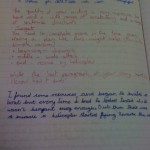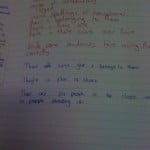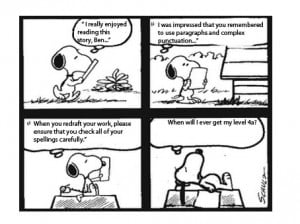When it comes to marking, I am with Phil Beadle who states, in ‘How to Teach’, “Make no mistake: this is the most important thing you do as a teacher.”
I recently looked at some of my exercise books from last year to look at the progress pupils had made over time. Overall, the class had improved but there were a handful of students who had not made the leaps that others had. They were marked regularly with good formative comments. Yet there were a few pupils who didn’t really improve the things that I had set for them as individual targets. They got better over time but the impact of my feedback was not particularly evident. I spent a great deal of my time on marking those books and I don’t want any of that time wasted! I don’t mark because I might get in trouble for not doing so- I mark because it will help my students. Therefore, one of my developmental targets this year has been to ensure that there is greater impact from my written feedback.
Sue Swaffield writes, in ‘Unlocking Assessment’ that the best practice in marking has the following common features:
- “Teachers are selective in their marking – deciding which pieces of work to give particular attention and which aspects of the work to focus on.
- Teachers identify successes related to the learning intention, pointing out particular parts of the work or making specific comments about it as a whole.
- They use comments only, not a grade or a mark, nor anything else that could be interpreted as such, for example a ‘sticker’, a ‘smiley face’ or a merit.
- Teachers indicate progress by referring to the pupil’s previous work.
- They specify something that could be improved, or the next steps to take, and give guidance on how to do so.
- Pupils understand the feedback, are clear about what it means and what they have to do.
- Time is routinely made available for pupils to work on their improvement points.
- Teachers work together to improve the quality of the feedback, and value quality above quantity.
- Pupils contribute to, and sometimes initiate, commentary and reflection on their work.”
I have tried to develop methods to ensure that my written feedback has the maximum possible impact. That includes many elements of the process: before, during and after.
BEFORE:Pupils’ work must be worth marking
This means getting the quality right to ensure that all that time spent marking is worthwhile.
I know that this seems painfully straightforward but it is important to share the success criteria for the piece of work. I have just marked a piece of work where I didn’t do this and had to write the phrase ‘remember to use spoken language terminology’ an awful lot. Using style models and analysing them before embarking on a new piece of work is also a useful way of making it explicit what success will look like.
Pupils also need to link the work that they are doing now with work that they have done in the past and, in particular, the feedback they have already received. There is nothing worse than writing exactly the same target for two pieces of work. I will often ask pupils to write their individual target at the top of the work so it is at the forefront of their thoughts. Pupils could answer a question at the end of their work as a nice bookend: ‘how has your writing improved since your last task?’ or ‘how have you met your target?’
When I send work emails or even when I tweet, I check them several times. (I have reread the final version of this blog 6 times) This is probably too much but I know that I will inevitably make some errors or just have some bits which don’t quite read right. Having a bit of time for pupils to check their work before handing in saves me a great deal of time and helps make my marking much more focussed.
Building in self/peer assessment and a little more time for redrafting makes it more likely that it is the best piece of work. (Pupils need to be taught how to do all these things effectively.)
Another excellent way of ensuring that pupils make it their best work is having a ‘real’ audience for their work. If they know others are going to read their work, they do not want to make any sloppy mistakes.
I’d also say at this point that I don’t formally mark every piece of work that the students produce. I read everything but I ensure pupils are aware when there is a task I will mark in detail. I find that marking in this way reduces my workload but increases the impact.
(I also nag nag nag about presentation. For me, it is important and makes clear that this is a piece of work to be proud of.)
DURING: Marking identifies progress/ Marking informs my/their next steps
Lots has been written on what good quality written feedback should look like. I will not go into too much detail here. I like Geoff Petty’s simple medal and mission idea. Comments only, no grades. Below is Dylan Wiliam speaking about feedback.
As I mark, I record targets on my marking spreadsheet. It helps me to build up a profile of pupils targets and I RAG whether they have met previous targets. It informs my teaching as well and I can see the bigger picture of the patterns in the class. (The colour coded markbook is a nice thing to show lesson observers to evidence progress over time too)
I reflect on the impact of my teaching. If the whole class are receiving the same target, is this because my teaching wasn’t quite up to it?
We have a ‘no red pen’ policy and are encouraged to use green. I use pink as a protest.
AFTER: Pupils engage with their feedback [Edit 28/11/15: I now feel that many of these ideas are awful as they a) take too much time and b) may take students away from actually concentrating on their feedback.]
Pupils need to be given time to process their feedback. At the very minimum they should be given explicit time to read their comments. Even better if lots of time is given to working with feedback. There is nothing wrong with spending a whole lesson engaging with feedback. Here are some ideas about how this could be done in notional order of complexity:
I like this simple idea from Kristian Still– feedback is written sideways in books so they have to turn books to read it.
Write a question after the feedback that they must answer.
Hide the feedback: Write the pupils’ comments in another page in the book. They have to find them. This might look strange in a book scrutiny however!
Correct the first half of a pupils’ work. They correct the second half.


 Give pupils an activity immediately to develop their target. I have done this above with my year 7 class. Interestingly, the pupil on the right has not used the homophones appropriately so it is instant feedback on my feedback and real evidence that the feedback wasn’t as effective as I had hoped. (That is pink pen by the way!)
Give pupils an activity immediately to develop their target. I have done this above with my year 7 class. Interestingly, the pupil on the right has not used the homophones appropriately so it is instant feedback on my feedback and real evidence that the feedback wasn’t as effective as I had hoped. (That is pink pen by the way!)
Self assessment 2.0: Pupils hand in a piece of work to be marked. The teacher photocopies it then marks as usual. In the feedback lesson, students mark their own then compare their version with the teacher’s. They then reflect on this.
 Cartoon feedback: My colleague made this. She used photoshop but there are a number of cartoon making sites such as ReadWriteThink and Witty Comics There are any number of ways that this could be used such as making a stock of blank ones. Teachers could leave the last bubble blank for pupils to comment.
Cartoon feedback: My colleague made this. She used photoshop but there are a number of cartoon making sites such as ReadWriteThink and Witty Comics There are any number of ways that this could be used such as making a stock of blank ones. Teachers could leave the last bubble blank for pupils to comment.
Coded Feedback: Feedback is written in such a way that it has to be ‘translated’ e.g. in another language, an anagram etc.
Late night marking (from The Lazy Teacher): Give pupils the wrong feedback and ask them to explain why it is the wrong feedback. I have developed this further by handing pupils their feedback on slips but to the wrong pupils. They have to find their own feedback.
Pupils must prepare a starter activity to teach the rest of the class on the subject of their target.
Arrange your seating plan to seat pupils with the same targets together. They can support each other and you can help them together. Alternatively, you could pair a pupil with a particular target with someone who is strong in that area.
A couple of acronyms: STAR: Strength, Target, Activity, Response; STEP: Strength, Target, Evaluation, Progress
I have tried to maintain a serious tone but I will add here that I have something called ‘Feedback Friday’ with its own theme tune and a call and response: ‘when I say feedback, you say Friday.’ I met a parent who told me in front of their embarrassed son that he sings it at home.
[…] The Goldfish Bowl – Reflections on teaching and learning. […]
[…] The Goldfish Bowl – Reflections on teaching and learning. […]
[…] routines for acting on feedback. I go into some detail about my routines for the whole process here. Make it a habit for students to read and act on feedback. They really value this when they are […]
[…] http://thegoldfishbowl.edublogs.org/2012/09/23/more-effective-written-feedback/ […]
[…] can read my detailed post about the specifics of making written feedback more effective here. Here are my views on how to get on top of […]
[…] Goldfish Bowl More Effective Written Feedback […]
[…] More Effective Written Feedback […]